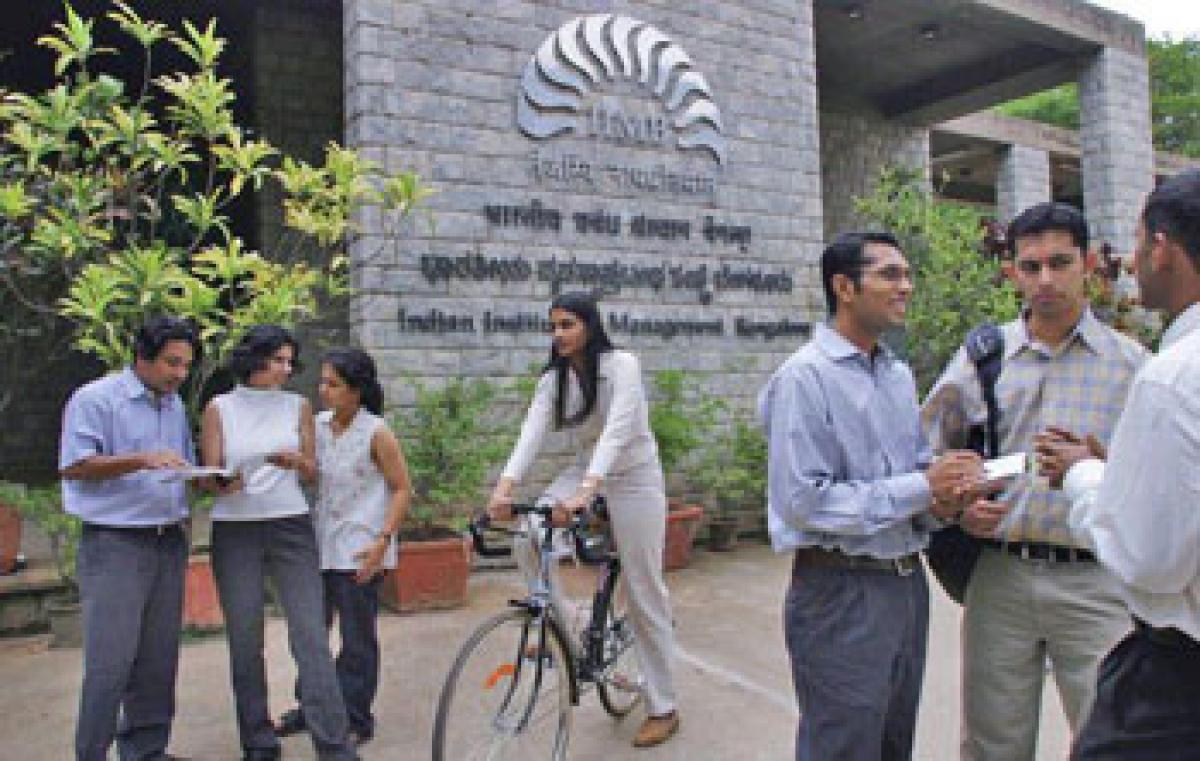Live
- ICC chief Jay Shah meets Brisbane 2032 Olympics organising committee CEO
- Oxford Grammar High School Celebrates 44th Annual Sports Day with Grandeur
- Indian banking sector’s health remains robust, govt policy working very well: Top bankers
- iOS 18.2 Unveiled: New Features with ChatGPT Integration Revolutionize Your iPhone
- 'Run for Viksit Rajasthan' to be annual event, says CM Sharma
- Nitish Kumar launches '109 free medicine vehicles' in Patna
- India have to play their best cricket at the Gabba to win series: Harbhajan
- Income tax refunds jump 46.3 pc to Rs 3.04 lakh crore in April-Nov
- Financial Intelligence Unit detects undisclosed income worth Rs 11,000 crore in 2024: Centre
- Odisha BJP chief to be elected in January
Just In

A prestigious brand name alone doesn’t help an institution attract students to its fold. That’s what the six new Indian Institutes of Management (IIMs) that enrolled their first batches this year have discovered.
 HRD ministry data shows that the six new IIMs that began classes in this academic session have not been able to fill up their seats
HRD ministry data shows that the six new IIMs that began classes in this academic session have not been able to fill up their seats
New Delhi: A prestigious brand name alone doesn’t help an institution attract students to its fold. That’s what the six new Indian Institutes of Management (IIMs) that enrolled their first batches this year have discovered.
None of the six—located in Sirmaur (Himachal Pradesh), Bodh Gaya (Bihar), Sambalpur (Odisha), Amritsar (Punjab), Visakhapatnam (Andhra Pradesh) and Nagpur (Maharashtra)—have managed to fill all the seats they offered.
Data from the human resource development (HRD) ministry shows that IIM-Sirmaur has just 22 students, IIM-Bodh Gaya 30, IIM-Sambalpur 48, IIM-Amritsar 45, IIM-Visakhapatnam 54 and IIM-Nagpur 55.
Each of these B-schools was supposed to enroll 140 students in their first academic session and raise the annual intake to 560 at the end of the sixth year. The HRD ministry later lowered its sights and reduced the student intake in the first year to 60, perhaps realising that the original goal was too ambitious.
The fact that these six institutions haven’t been able to meet even the reduced target shows, for one, that just the name IIM, however elite a ring it has to it isn’t enough to lure students.
“Just the name is no more a ticket to success,” said Narayanan Ramaswamy, partner (education practice) at consulting firm KPMG. “IIMs are brands, but government opening new ones in any part of the country is not going to help. Business schools coming up away from business hubs are definitely at a disadvantage.”
The location, infrastructure and quality of faculty are equally important to students. Instead of creating new IIMs from makeshift campuses with poor facilities, the government should have adopted a more far-sighted approach towards establishing the new institutions, experts say.
Since 2007, the number of IIMs has tripled from six to 19; yet another one in Jammu and Kashmir is in the pipeline. Of the original six, IIM-Ahmedabad, IIM-Calcutta and IIM-Bangalore remain the top draws for the best and brightest of the students who take the annual Common Admission Test for admission to these B-schools. IIM-Lucknow, IIM-Kozhikode and IIM-Indore are the other three.
For state governments, hosting an IIM gives them bragging rights to being home to a brand-name institution. It’s common for state governments to lobby for the centrally funded institutions to be set up in their territories.
“The government seems to have fallen victim to political pressure from states,” said a professor from an older IIM who didn’t want to be identified. “IIM-Kashipur, established by the previous government, should have been a learning experience for the new administration.”
The HRD ministry faced a tough time in hiring faculty for the IIM in Kashipur, Uttarakhand, which opened in 2011.
The IIM in Odisha was to have been established in Bhubaneswar, the state capital, but was shifted to Sambalpur, nearly 300km away, because of political lobbying. IIM-Sambalpur completed its admission process only by September-end after a delay of several weeks. Earlier this year, a government-appointed committee suggested to the HRD ministry that top centrally funded institutions should be opened only in accessible locations with good infrastructure and connectivity.
Source: livemint.com

© 2024 Hyderabad Media House Limited/The Hans India. All rights reserved. Powered by hocalwire.com







